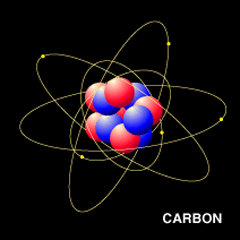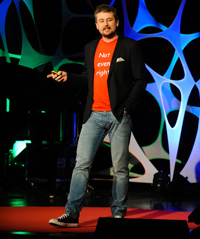
Particle hunting at the LHC: the particles
CERN's Large Hadron Collider (LHC) is the world's largest laboratory experiment. It's a particle accelerator sitting about 100m below the Earth's surface, in a huge tunnel on the Franco-Swiss border. The experiment has smashed together tiny particles of matter in over a million billion collisions in the hope of finding answers to some deep questions about the way our Universe works. This article is about the particles involved, but you can also read brief introductions to the the theory behind the experiment, the triumphant discovery of the Higgs boson and what other mysteries the LHC might solve.
How tiny are the particles?

Electrons orbiting the nucleus of a carbon atom. Image courtesy NASA.
Consider an atom of carbon, one of the most ubiquitous elements on Earth. It's about a tenth of a billionth of a metre across, about one millionth of the breath of a human hair. This atom is mostly space — some particles, electrons, are zipping around the edge, but in the middle lies a hard centre, the carbon nucleus, which is about one ten-thousandth the size of the whole atom. If we picked apart the nucleus, we'd find that it is made of twelve particles stuck together. Of these, six have a positive electric charge, they are called protons, while the other six are neutrons, which have no electric charge. Protons measure roughly a thousandth of a billionth of a millimetre across. It is these tiny particles that the Large Hadron Collider smashes together to within a cat's whisker of the speed of light.
Electron Jelly
It is easy to be lulled into thinking of a particle as a tiny billiard ball. But delving into quantum theory (which describes the physics of the infinitesimally small), we find that things are much more interesting: it appears that the billiard ball picture is only an approximation of reality. Electrons, for example (though the example applies to all of the other known fundamental particles as well), are better thought of as a weird sort of quantum jelly, which fills space.
Like any liquid, the jelly can be calm like the surface of an undisturbed lake, or it can ripple. In the parts of space where the jelly is calm, we measure a vacuum. But where there a ripples in the jelly, we measure an electron. There is only one electron jelly, and it fills the Universe. It contains ripples in countless different places, and in each ripple, we could measure an electron.
What's more, ripples in the electron jelly tend to produce ripples in the photon jelly, and vice versa. Thus, moving electrons tend to "produce photons". On the other hand, photon jelly ripples can effect electron jelly ripples and so electrons "feel" the force of the photons. This is the electromagnetic force (i.e. the photon jelly) acting on the electrons. Of course the jelly is only an analogy: there is a precise mathematical theory that describes it, and which talks about quantum fields instead of jelly. And this theory, the standard model of particle physics, is being tested at the LHC.
About the author

Ben Allanach is a Professor in Theoretical Physics at the Department of Theoretical Physics and Applied Mathematics at the University of Cambridge. His research focuses on discriminating different models of particle physics using LHC data. He worked at CERN as a research fellow and continues to visit frequently.